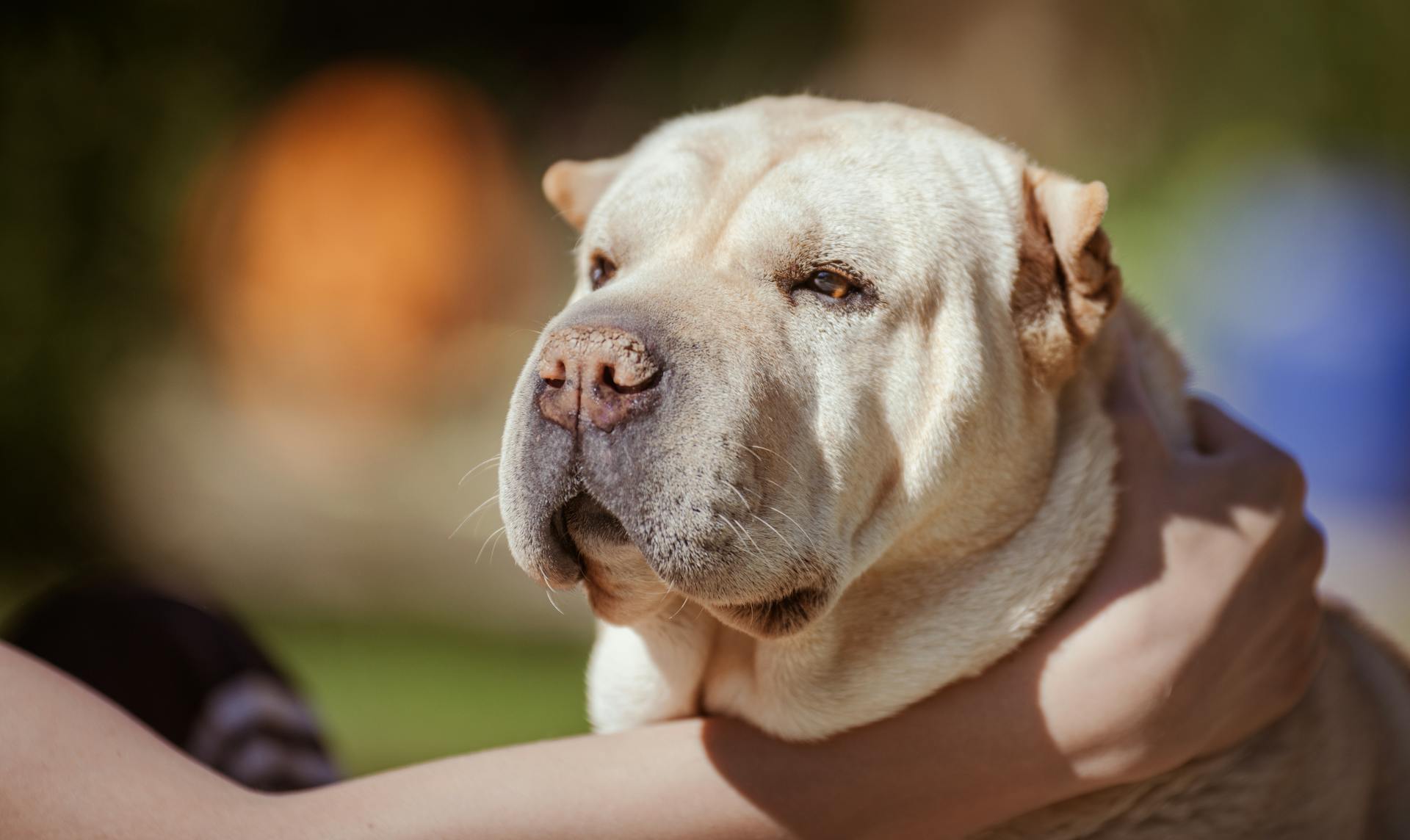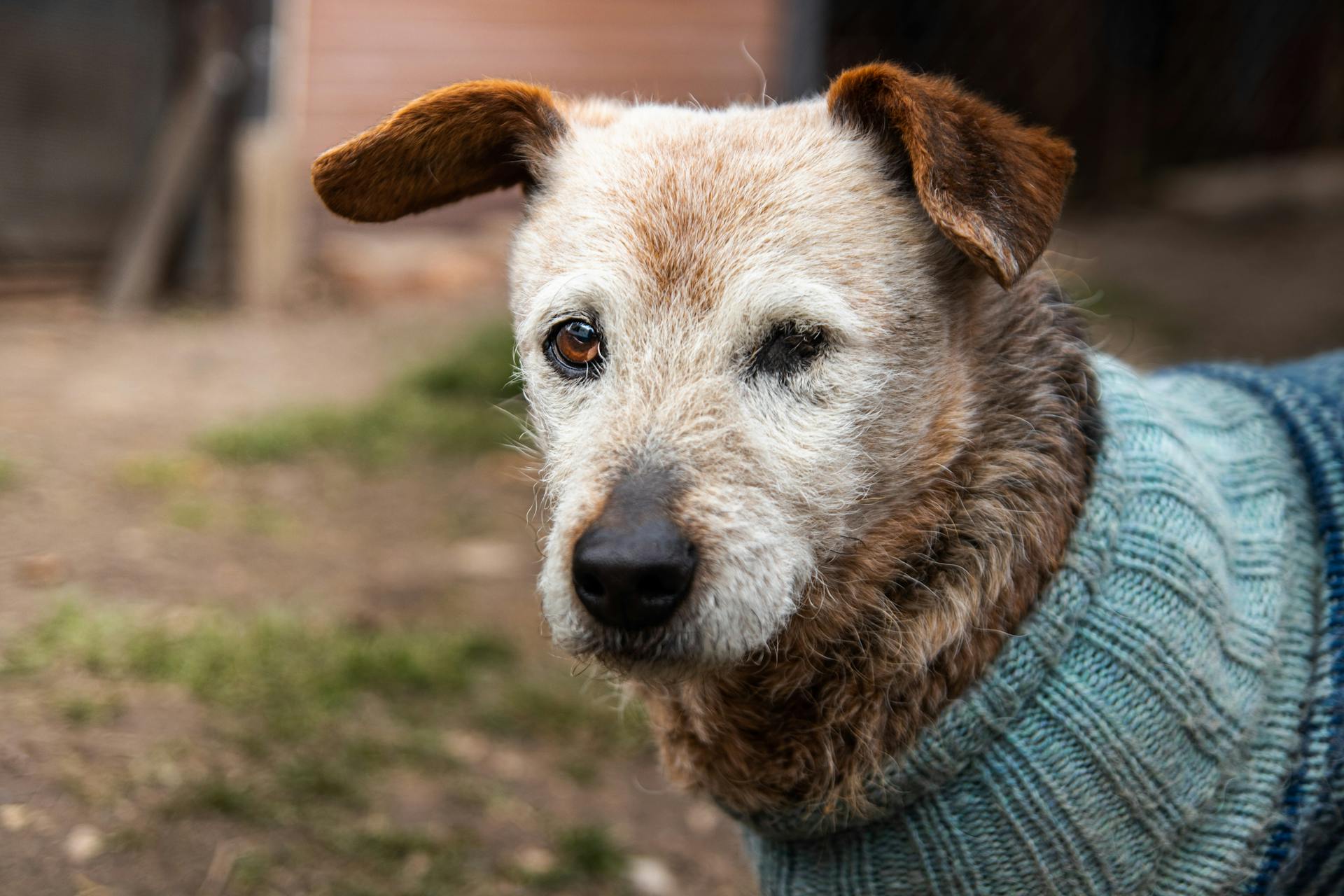
Aging spots on dogs can be a normal part of the aging process, but they can also be a sign of underlying health issues.
These spots, also known as age-related skin lesions, can appear on a dog's skin as they get older, typically starting around 5-7 years of age.
They can be caused by a combination of factors, including sun damage, genetics, and hormonal changes.
Some common symptoms of aging spots on dogs include changes in skin texture, color, and size, as well as the appearance of new growths or lesions.
One of the most common types of aging spots is a seborrheic keratosis, which is a benign tumor that can appear as a brown or black spot on the skin.
Aging spots can be treated with a combination of topical creams, medicated shampoos, and in some cases, surgery.
In some cases, aging spots can be a sign of a more serious underlying condition, such as liver disease or cancer, so it's essential to have your dog checked by a veterinarian if you notice any unusual skin changes.
Suggestion: Miniature Schnauzer Skin Problems
Causes and Risk Factors
Dogs with allergies, hypothyroidism, obesity, and mange are more likely to develop areas of skin that become dark due to chronic irritation.
Hyperpigmentation is common in dogs with underlying skin conditions that cause frequent licking, scratching, or skin that rubs, such as allergic dermatitis or obesity.
Hairless breeds are more prone to developing hyperpigmentation since they don't have much fur to protect their skin.
Some common causes of hyperpigmentation in dogs include hypothyroidism, which affects up to 33% of dogs diagnosed with the condition, and systemic lupus erythematosus, a disease that can cause a range of symptoms including hyperpigmentation.
Allergies, Malassezia yeast infections, and Demodicosis, a mite infection, can also lead to hyperpigmentation.
Dogs with these conditions may develop clearly defined, raised, dark spots with clearly defined margins, which can be a sign of a skin tumor.
Here are some common causes of hyperpigmentation in dogs:
- Hypothyroidism: Up to 33% of dogs diagnosed with hypothyroidism show signs of hyperpigmentation.
- Systemic Lupus Erythematosus: Some dogs diagnosed with lupus develop hyperpigmentation.
- Allergies: If your dog experiences allergies, he may also develop hyperpigmented areas on his skin.
- Malassezia: A yeast infection that often has hyperpigmentation as a symptom.
- Demodicosis: A mite infection that can cause hyperpigmentation.
- Pseudo-Cushing’s Syndrome: An endocrine disorder that can have hyperpigmentation as a result.
Skin Tag
Skin tags are a common issue in older dogs, and some breeds are more prone to them than others.

They typically grow in areas where a dog's skin rubs together, such as the neck, armpits, or groin.
Skin tags are overgrowths of the connective tissue in the skin, and they're usually the same color as the surrounding skin.
They extend out from the surface on thin stalks, which can be a bit unsightly.
No treatment is needed if skin tags aren't causing any problems, but they can be surgically removed if they're bothersome.
Check this out: Shih Tzu with Skin Allergies
Basal Cell Tumors
Basal Cell Tumors are benign growths that develop on the head, ears, neck, and forelimbs of older dogs.
They are raised swellings that are typically firm, solitary, dome-shaped, and small. Some may be hairless, ulcerated, and stick out like stalks from the surface of the skin.
Basal Cell Tumors are dark in color and may form cysts that break open and drain fluid or pus.
Treatment for Basal Cell Tumors is surgical removal, especially when the dog is uncomfortable.
Causes and Risk Factors

Dogs with certain health conditions are more prone to developing hyperpigmentation. Hypothyroidism, for example, can cause up to 33% of affected dogs to show signs of hyperpigmentation.
Allergies are another common cause of hyperpigmentation in dogs. If your dog experiences allergies, he may develop darkened areas on his skin.
Some breeds are more susceptible to hyperpigmentation due to their lack of fur. Hairless breeds, for instance, don't have much protection for their skin, making them more prone to dark spots.
Malassezia, a yeast infection, can also cause hyperpigmentation as a symptom. This is just one of the many potential causes of darkened skin in dogs.
Here are some of the underlying conditions associated with hyperpigmentation in dogs:
- Hypothyroidism
- Systemic Lupus Erythematosus
- Allergies
- Malassezia
- Demodicosis
- Pseudo-Cushing’s Syndrome
These conditions can cause chronic irritation, which in turn leads to hyperpigmentation. It's essential to get a veterinary opinion if you notice any changes in your dog's skin.
Symptoms and Diagnosis
Symptoms of aging spots on dogs can be quite noticeable. The affected areas may become light brown to black in color.
Skin changes can occur, making the impacted area feel velvety, rough, or thickened, and hair loss may also be present.
The groin, legs, and armpits are common areas where you'll notice these changes.
A secondary bacterial or yeast infection can cause the affected area to appear red around the edges.
Here are some common symptoms to look out for:
- Discoloration
- Skin changes (velvety, rough, thickened)
- Hair loss
- Redness around the edges (due to secondary infections)
Symptoms and Diagnosis
Symptoms of hyperpigmentation in dogs can be quite noticeable. Discoloration is a common sign, with affected areas turning light brown to black in color.
The impacted area may become velvety, rough, thickened, and even experience hair loss. Skin changes can be a significant concern for dog owners.
Areas prone to hyperpigmentation include the groin, legs, and armpits. These areas are often the first to show signs of discoloration.
You may notice redness around the edges of the affected area. This is usually due to a secondary bacterial or yeast infection.
Here are some common areas where hyperpigmentation is often found:
- Armpits
- Belly
- Flanks
- Inner thighs
Diagnosis of hyperpigmentation is typically made through a physical exam and history. Your veterinarian will want to perform a full examination to identify any underlying causes.

Gentle scrapings of the skin may be taken to determine if parasites or infections are present. If allergies are suspected, food trials may be done to isolate the cause of symptoms.
Testing may be done to ensure your veterinarian has identified the underlying cause of your dog's symptoms. However, further testing is usually not necessary to diagnose hyperpigmentation.
Secondary
Secondary symptoms can be a red flag for a secondary bacterial infection or yeast infection, often signaled by inflamed areas with red edges.
Inflamed areas can spread to different parts of your dog's body, including the groin, abdomen, ears, and around the eyes.
Hyperpigmentation can lead to itchiness and discomfort for your canine companion.
Hair loss, fluid discharge, and infections can be further complications of untreated hyperpigmentation.
Taking your dog to a vet for examination and diagnosis is crucial to start treatment sooner.
Frequently Asked Questions
What are the brown spots on my dogs privates?
Brown spots on your dog's privates may be early signs of yeast, often mistaken for dirt or fleas. Check for other symptoms and consult a vet to confirm the cause and ensure your dog's health.
Sources
- https://www.petmd.com/dog/symptoms/lumps-bumps-and-cysts-dogs
- https://vetster.com/en/symptoms/dog/skin-turning-black
- https://wagwalking.com/condition/hyperpigmentation
- https://www.vetdermclinic.com/what-is-hyperpigmentation-in-dogs-learn-about-this-skin-condition/
- https://www.newtownvets.com/site/blog/2022/03/15/what-is-hyperpigmentation-in-dogs
Featured Images: pexels.com


